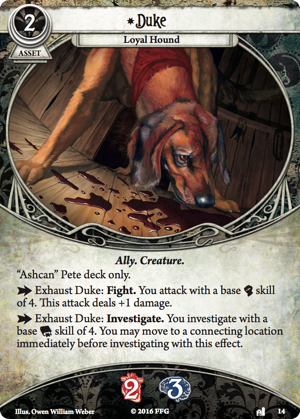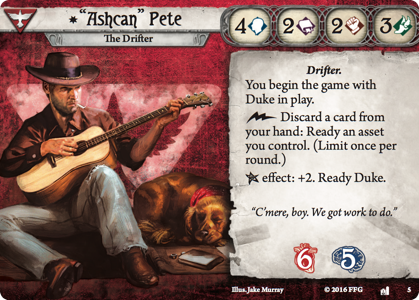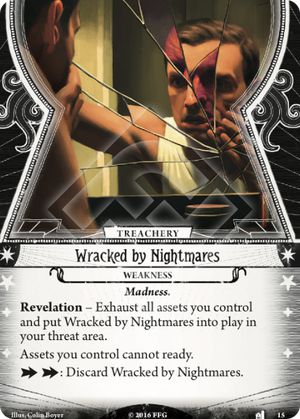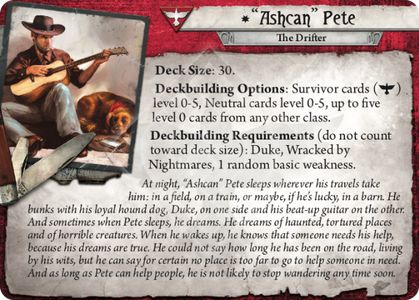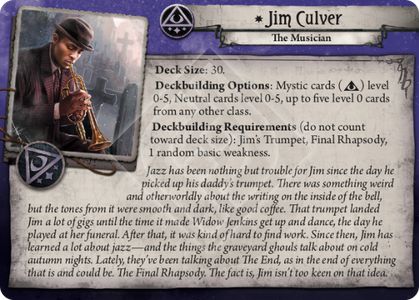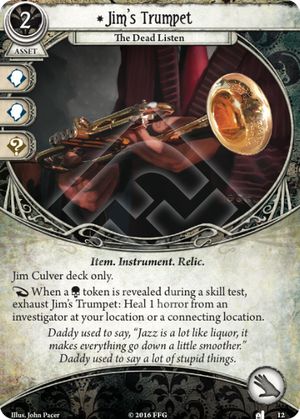Fantasy Flight Games is releasing new Mythos Packs at a very
decent pace. Not long after the previous card-discussing post it’s time for a
new one. Essex County Express has arrived, bringing 12 new player cards (2 from
each class)! I will give cards more a detailed look this time. Please let me
know if you found it useful!
There are two new neutral cards with the permanent keyword, granting
investigators an extra slot. At a reasonable cost of 3 experience points you
can try some fancy combinations of assets. As of now, Charisma is definitely
the stronger one. There are multiple strong allies out there (not to mention
few you can get during the Dunwich Legacy campaign). There are multiple valid
combinations, so I don’t think it’s worth to mention all of them, just please
keep an eye on following options. You can have two copies of the same ally in
the game (particularly Beat Cop), just make sure it’s not a unique one! You
should also be aware of possible using the extra slot to play one time effect
allies (Seekers have two at this moment) If you are really planning to center
your game on allies, two copies of Charisma might come even more handy.
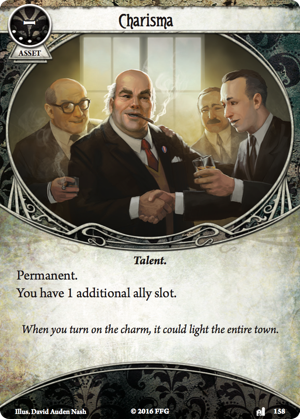 |
| Charisma is a cool and needed card. And makes me want having Charlie Kane even more! |
There are significantly fewer strong accessories as of now,
though one can think of a good use for Relic Hunter. Particularly Waitress-Witch
Agnes seems to be the best candidate as of now. I personally wasn’t able to fit
any copies of Rabbit’s Foot in her deck, but it seems to be a valid choice,
particularly with the new permanent talent around. I have also encountered
different ideas, some of which seemed controversial or suboptimal to me. First
one was Roland with Elder Sign Amulet and Police Badge – just too much XP
invested, in my opinion. The other was Zoey with a Holy Rosary and Zoey’s Cross
– rather a debatable idea of filling the out of class slots with Holy Rosary. Accidentally,
Police Badge sounds like a decent option for her, if the goal is to boost her
Will. With Relic Hunter in the card pool we can hopefully expect to see more accessories
in future Mythos Packs.1
One may just wonder, why being a Relic Hunter gives you an
additional neck to hang a necklace on.
The list of “slot adding” cards does not end here. Guardians
got Bandolier, an elegant solution to their constant hand – related issues.
While not allowing them to reach quite the Kali level, it provides a much
needed help. Guardians have been struggling with the hand slot limitations pretty
much since day 0. Regardless of what do you need more slots for – to put a
Flashlight/Magnifying Glass, or just to be able to pull out both Shotgun and
Machete, Bandolier provides a strong help. A requirement to use the extra slot
for a weapon is trivial, as you’re going to have one anyway. One extra health
is just a cherry on top. Bandolier is in a way a similar card to
Book of Shadows – giving a free slot, but occupying another one. However, it
fills a rather less useful slot and costs no XP.
The next Blue card is an absolute blast. I was waiting to
finally include it in my decks since I’ve seen the preview. You all know, how
much I love the team cards and this one is not only playing right into the
theme. It is also a very strong one! For one action and one card you get 4
resources and 4 cards. Moreover, usually spreading the gain is much more
effective, as excessive cards need to be discarded.2 AND it has two
Will icons! What a great card and what a headache for Guardians – they have so
many great cards to consider already, when leveling up.
 |
| Usual graphics rant: Why is one investigator and ghost? What kind of strange glasses does the other one have? |
Seekers got one upgraded and one un-upgraded card as well. Art
Student is rather on the weaker end of the spectrum. Clue for an action is not
terribly efficient – unless you need to deal with Locked Door – kind of
situation or a tough location, you could just as well investigate. Bit of a
damage/horror buffer dos not sound too strong neither, as she occupies the ally
slot (more about slots and opportunity costs here). The best idea to use her
would be for a character with Charisma, particularly Roland, who needs extra
Sanity the most. In this way she reminds a bit of Laboratory Assistant.
The upgraded Deduction is a card we saw coming. Not only because
of the previews, but also due to the role it fills. It is nicely balanced;
getting full benefit out of it is not too easy. Cost of two XP makes it a viable
choice for Roland (and possibly more incoming investigators, who can take cards
of level 0-2 from a single second class). With more and more of similar cards,
Double or Nothing will get even stronger - can you imagine getting 6 clues with
this synergy in a single action?! It also begs the question, if we’ll see
similarly upgraded versions of Vicious Blow, Fearless and (tougher to imagine,
as the design would have to be non-obvious) Opportunist and Survival Instinct.
Rogues finally got a good weapon! While stocking on
different interesting little cards, they have been so far lacking a pure power,
easy to use means of fighting and investigating. We’ll have to wait more for
the later to come; a strong weapon has finally arrived, though. Switchblade’s 0
level version is very poor, the stronger 2 XP one is definitely superior. The Combat
boost provides a decent shot at succeeding and – more importantly – at doing
some serious damage, further expanding the “succeed by 2 or more” Rogue theme.
While still not a perfect weapon (it’s basically a fast, unlimited uses version
of .41 Derringer), it finally gives Rogues a chance to deal with enemies at
cost of 2 XP. It will definitely be an auto-include for me.
 |
| Easily the last taken Green card. |
"I'm outta here!" sparked quite a discussion on a
Polish AH:TCG group I am member of. A very strong observation has been made –
many cards with two icons can be seen primarily as committable ones. Option to
play them for their “real” effect is merely a nice addition. One can compare
them with the neutral skill cards – they also primarily offer two icons. So is
the new level 0 rogue card – you will use it very rarely. You can, however just
commit it at any Agility test for juicy 2 icons.
There is one problem with this view – skill cards allow you
to draw a card, if you pass the test. It is a very strong effect, basically a
FREE ACTION. It is not to be easily disregarded. In fact, it costs 2 XP to
upgrade Lucky! to a stronger, card drawing version! Therefore, having a non-skill
card, that will be used just for icons, in most of the cases sounds like a poor
choice to me. You could theoretically want to have more 2-icon cards and choose
I’m outta here! or Oops! For this purpose, but it’s rather unlikely.
Resigning is sometimes a valid option (and in rare cases
even a way to win a scenario!), however the card seems very situational. I am
not sure if I’d include any copy without knowing in advance it’d be useful in a
particular scenario. And I rather prefer not to optimize decks for scenarios
(as mentioned here). The card deserves some extra credit for being a very thematic
one (by thematic I mean – very character – suiting one, having a strong RPG
feel).
My favorite class (Mystics) did not get any obvious
powerhouses this time, though they do not have a reason to complain neither.
Level 3 version of Shrivelling, offering an extra Will boost is a decent card.
While Agnes might not need the bonus too heavily, it’s a life-saver for Jim. Along
with Book of the Dead he can become a very proficient fighter. It is bit
unfortunate, it is not a level 2 card – Daisy and other future characters
limited to 2 level cards could really use the bonus.
*SPOILER ALERT* The card makes much more sense, when put
into long term perspective. We happen to know there will be level 5 version of
Shrivelling. It makes sense to take a lesser one on your way (due to the rule,
allowing you to pay the XP cost of level difference only), not to have “saved
XP” not yielding any benefit. *SPOILER ALERT*.
Hypnotic Gaze is another card, gaining an extra edge when
used by Jim (told ya huh?). And another one, allowing players to use
symbol tokens to their advantage, which is a nice design touch – not everything
has black’n’white effects on the gameplay. At first sight It seems bit costly,
compared to Dodge. However, it is mostly due to it not exactly being a
Mystic-themed card (avoiding damage is not a typical Mystic thing), while Dodge fits perfectly in the Guardian archetype. To get beyond your usual
capabilities, you must pay a higher price. While Jim gets an extra token he can
use to trigger the second part of Hypnotic Gaze, it has added value for
everyone. Daisy is particularly interested in avoiding damage and should
consider having a copy or two. Agnes will be very happy about the “Spell”
trait.
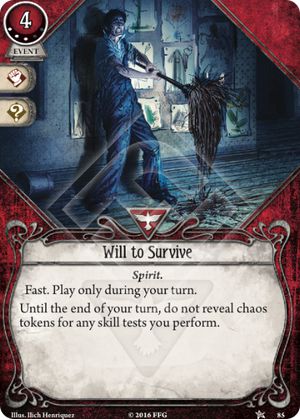 |
| The only high level Survivor card. |
Survivors once again got a nice interesting card. Newspaper is a very unusual boost to investigating – only working if you have no clues.
It is very hard to establish how useful this card is, without knowing a
particular scenario. There are scenarios like “Midnight Masks”, in which it
might help you a lot. There are also quite a few, during which you only spend
clues once or twice – it would make Newspaper significantly weaker than a
Flashlight.
Newspaper is obviously weaker than Magnifying Glass. It is
to be expected, though – Seekers excel at gathering clues, hence their clue
related cards have to be the strongest ones out there. It is much more
interesting (and useful!) to compare it with a Flashlight. They both provide a
boost of two. Flashlight’s Shroud reduction is a bit more handy, though. First of
all, reducing the Shroud to 0 all but guarantees succeeding (only auto-fail
chaos token would cause you to fail the test). Secondly, it provides a stronger
help, when using Double or Nothing!. Finally, it helps with locations which are
not investigated using Intellect. Flashlight is a bit more expensive. Most of
the value difference will be decided by how many times you are able to use
them. For Flashlight the answer is simple, it has 3 charges. Newspaper’s uses,
as I mentioned before are uncertain – in some scenarios you can definitely use it
more often than 3 times. In some, just once or twice (particularly if drawn
later). A good item for both Agnes and Pete to get their first clue (Pete can
use it first while investigating on his own, using Duke at the 2nd
try.)
Lure makes me a bit worried. It’s a 3rd Survivor
level 1 card in a row, which means there are not too many high level red cards
to take. It’s made even worse by Flare and Fire Extinguisher being Exile-based
cards. Moreover, Lure is not too strong of a card, neither. To use it
efficiently you need a triangle of locations, one of which contains hunter
enemy, one with the character himself and a 3rd one, where you plan
to go. As already discussed earlier, two icons do not make a situational card
good by themselves. Lure would be definitely a better card if it lasted one more
turn, effectively keeping the monster trapped or at least making him to chase
it for longer. It hurts even more, as the card costs 1 XP, I wouldn’t be sure
if I’d include it even if it was a 0 level card.
TL;DR version:
Strongest/Weakest card: Stand Together/Lure
Most/least thematic cards: "I'm outta here!"/Relic
Hunter
My favorite/ least favorite card: Switchblade/Art Student
1I am also still waiting for a cool Tome for
Daisy! Even a stronger version of Encyclopedia or Old Book of Lore wouldn’t be
too bad.
2Not to mention the law of diminishing marginal utility,
which just as applicable in board games as in real life.

